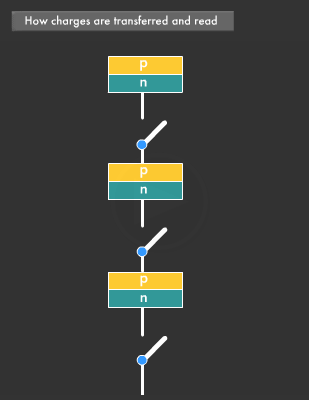What Does Ccd Stand For In Cameras
Canon Scientific discipline Lab
CCD Sensors
CCD stands for "accuse coupled device," a semiconductor prototype sensor used in digital cameras to convert light into electrical signals.
In identify of the moving-picture show used in conventional motion picture cameras, digital cameras incorporate an electronic component known as an paradigm sensor. Most digital cameras are equipped with the image sensor known as a CCD Sensors, a semiconductor sensor that converts light into electric signals. CCD Sensors are made upwards of tiny elements known as pixels. Expressions such equally "2-megapixel" and "4-megapixel" refer to the number of pixels comprising the CCD Sensors of a photographic camera. Each pixel is in fact a tiny photodiode that is sensitive to lite and becomes electrically charged in accordance with the strength of lite that strikes it. These electrical charges are relayed much like buckets of h2o in a bucket line, to eventually exist converted into electrical signals.
The Way Calorie-free Is Converted Into Electric Current
The surface of a CCD Sensors is packed with photodiodes, each of which senses calorie-free and accumulates electrical charge in accordance with the strength of light that strikes it. Let's take a look at what happens in each photodiode. Photodiodes are, in fact, semiconductors, the about basic of which is a pn pair made up of a p-type and an northward-blazon semiconductor. If a plus electrode (anode) is attached to the p-type side, and a minus electrode (cathode) is attached to the northward-type side of the pn pair, and electric current is and so passed through this circuit, current flows through the semiconductor.

This is known as forward bias. If you create a reversed circuit by attaching a plus electrode to the n-type side, and a minus electrode to the p-type side of the pn pair, and so electrical current will be unable to flow. This is known as opposite bias. Photodiodes possess this reverse bias structure. The main difference from standard semiconductors is the way in which they accrue electrical accuse in direct proportion to the amount of lite that strikes them.
Photodiodes Accumulate Electric Accuse
Photodiodes are designed to enable light to strike them on their p-blazon sides. When light strikes this side, electrons and holes are created within the semiconductor in a photoelectric effect. Light of a curt wavelength that strikes the photodiode is absorbed by the p-type layer, and the electrons created as a event are attracted to the n-type layer. Calorie-free of a long wavelength reaches the n-type layer, and the holes created equally a outcome in the n-type layer are attracted to the p-blazon layer. In curt, holes gather on the p-blazon side, which accumulates positive charge, while electrons assemble on the due north-type side, which accumulates negative charge. And considering the excursion is reverse-biased, the electrical charges generated are unable to flow.

The brighter the light that hits the photodiode, the greater the electrical charge that will accrue inside information technology. This accumulation of electric accuse at the junction of the pn pair when light strikes is known every bit a photovoltaic effect. Photodiodes are basically devices that make use of such photovoltaic effects to convert lite into electrical charge, which accumulates in direct proportion to the strength of the light hitting them. Photodiodes are likewise at work in our everyday lives in such devices every bit infrared remote control sensors and camera exposure meters.
CCD Sensors Relay Electrical Charge Like Buckets of Water in a Bucket Line
CCD Sensors comprise photodiodes and mechanisms consisting of polysilicon gates for transferring the charges accumulating within them to the edge of the CCD. The charges themselves cannot be read as electric signals, and need to be transferred across the CCD Sensors to the edge, where they are converted into voltage. By applying series of pulses, the charges accumulated at each photodiode are relayed in succession, much like buckets of water in a bucket line, down the rows of photodiodes to the edge. CCD is the abbreviation of "Charge-Coupled Device," and "Charge-Coupled" means the manner charges are moved through gates from one photodiode to the next.

Source: https://global.canon/en/technology/s_labo/light/003/04.html
Posted by: nelsoncovelf.blogspot.com


0 Response to "What Does Ccd Stand For In Cameras"
Post a Comment